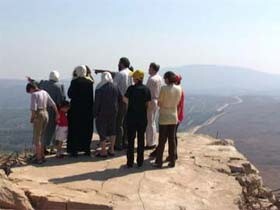The Electronic Intifada 28 April 2005

A film still from “Land of ‘48”
Because he carries a Danish passport, Lebanese Rima can move freely from country to country, something prohibited to his subjects. Acting as a surrogate, Rima visits one woman’s old village near the city of Safad, capturing it on film so she can watch it with her friends. Even though the names have changed, this land commands a powerful presence over its viewers.
Throughout his film, Rima makes a point of listing the number of registered refugees that reside in each country — 400,000 in Syria, 150,000 in the West Bank and the Gaza Strip and a staggering 1,800,000 in Jordan. In each country he talks to a dozen or so nameless (but listed in the credits) Palestinians who welcome him into their homes and passionately address their relationship to their homeland. All agree that no matter what their lives are like in their current residence, pre-1948 Palestine is the place they call home. One man pointedly remarks, “Everything we build outside our country is just a sandcastle. Everything is a mirage.”
Others do what ever they can to hold on to their memories. One woman empties a basket that holds the paperwork and even the key for her house in Palestine, while another keeps her grandfather’s land tax receipts that he paid each year to the Palestinian government. In a decidedly symbolic gesture, an older man who lived through the exodus fervently explains that he ingested the earth that he brought back from a visit to his old village, so “at least [he’d] have the earth in [his] stomach.”
But Land of ‘48 does not merely depict the stories of people who long for their homeland; it addresses larger issues such as the complications that surround the refugees’ right of return. Questions without concrete answers are posed, such as who has this right and what does it mean for those who are living on the land now. “Is being born somewhere enough for one to belong there?” Do those who were born refugees in other lands such as Lebanon or Syria have a right to return to the homes that once belonged to their family? One man whose family left Ramleh in ‘48 explains, “I have never lived there but a bond exists.”
In between the stories are cinematically stunning shots of the land in question. As refugees look out over where they once lived, Rima’s camera captures the subtle beauty that stretches beyond just memory. Scenes also indulge silent portraits of the interviewees, speaking without need of translation. In the end, Land of ‘48 provides no answers, but opens up the discourse surrounding the emotions which pervade its topic. Perhaps a man living in Syria says it best when he explains, “One’s relationship to a place is not just material relation to the sand, the earth, and property. It’s a relationship to culture, history and the horizon.”
Jenny Gheith is a film critic for the Electronic Intifada
Related links:





